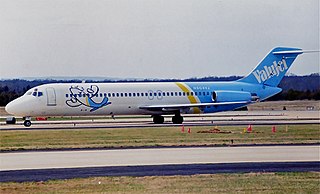
ValuJet Airlines Flight 592 was a regularly scheduled flight from Miami to Atlanta. On May 11, 1996, the ValuJet Airlines McDonnell Douglas DC-9 operating the route crashed into the Everglades about 10 minutes after taking off from Miami as a result of a fire in the cargo compartment caused by mislabeled and improperly stored hazardous cargo. All 110 people on board died. The airline already had a poor safety record before the crash, and the accident brought widespread attention to the airline's problems. The airline was grounded for several months after the accident. When operations resumed, ValuJet was unable to attract the same numbers of customers as it had before the accident. It acquired AirTran in 1997, but the lingering damage to the ValuJet name led ValuJet executives to assume the AirTran name.

Delta Air Lines Flight 1141 was a scheduled domestic passenger flight between Dallas/Fort Worth, Texas and Salt Lake City, Utah. On August 31, 1988, the flight, using a Boeing 727-200 series aircraft, crashed during takeoff, resulting in 14 deaths and 76 injuries of the 108 on board.
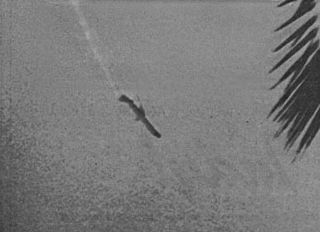
Aeroméxico Flight 498 was a scheduled commercial flight from Mexico City, Mexico, to Los Angeles, California, United States, with several intermediate stops. On Sunday, August 31, 1986, the McDonnell Douglas DC-9 operating the flight was clipped in the tail section by N4891F, a Piper PA-28-181 Cherokee owned by the Kramer family, and crashed into the Los Angeles suburb of Cerritos, killing all 64 on the DC-9, all three on the Piper and an additional 15 people on the ground. Eight on the ground also sustained minor injuries. Blame was assessed equally on the Federal Aviation Administration (FAA) and the pilot of the Cherokee. No fault was found with the DC-9 or the actions of its crew.

On the evening of February 1, 1991, USAir Flight 1493, a Boeing 737-300, collided with SkyWest Airlines Flight 5569, a Fairchild Swearingen Metroliner turboprop aircraft, upon landing at Los Angeles International Airport (LAX). Though air traffic was not heavy at LAX, as Flight 1493 was on final approach, the local controller was distracted by a series of abnormalities, including a misplaced flight progress strip and an aircraft that had inadvertently switched off the tower frequency. The SkyWest flight was told to taxi into takeoff position, while the USAir flight was landing on the same runway.

ValuJet Airlines, later known as AirTran Airlines after joining forces with AirTran Airways, was an ultra low-cost U.S. airline, headquartered in unincorporated Clayton County, Georgia, that operated regularly scheduled domestic and international flights in the Eastern United States and Canada during the 1990s. The company was founded in 1992 and was notorious for its sometimes dangerous cost-cutting measures. All of the airline's planes were purchased used from other airlines; very little training was provided to workers; and contractors were used for maintenance and other services. The company quickly developed a reputation for safety issues. In 1995, the military refused ValuJet's bid to fly military personnel over safety worries, and officials at the FAA wanted the airline to be grounded.

Candalyn "Candi" Kubeck was an American commercial airline pilot and the captain of ValuJet Flight 592. This flight crashed into the Everglades in 1996, after oxygen generators illegally placed in a cargo hold started and maintained a fire that disrupted aircraft functionality and flooded the entire cabin and cockpit with smoke. The crash made Kubeck the first female captain to die in a commercial airline crash.
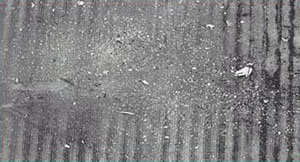
American Eagle Flight 4184, officially operating as Simmons Airlines Flight 4184, was a scheduled domestic passenger flight from Indianapolis, Indiana to Chicago, Illinois, United States. On October 31, 1994, the ATR 72 performing this route flew into severe icing conditions, lost control and crashed into a field. All 68 people aboard were killed in the high-speed impact.

Rich International Airways was primarily a United States charter and cargo airline founded by aviation pioneer Jean Rich, one of the few women in the U.S. to own and operate an airline. The air carrier was based in Miami, Florida. The airline ceased operations in 1996, following bankruptcy.

Addison Airport is a public airport in Addison, in Dallas County, Texas, United States, 9 mi north of downtown Dallas. It opened in 1954 and was purchased by the town of Addison in 1976. It is home to the Cavanaugh Flight Museum.

Piedmont Airlines Flight 22 was a Piedmont Airlines Boeing 727-22 that collided with a twin-engine Cessna 310 on July 19, 1967, over Hendersonville, North Carolina, United States. Both aircraft were destroyed and all passengers and crew were killed, including John T. McNaughton, an advisor to U.S. Secretary of Defense Robert McNamara. The aircraft were both operating under instrument flight rules and were in radio contact with the Asheville control tower, though on different frequencies. The accident investigation was the first of a major scale conducted by the newly created National Transportation Safety Board. A review of the investigation conducted 39 years after the crash upheld the original findings that had placed primary responsibility on the Cessna pilot.
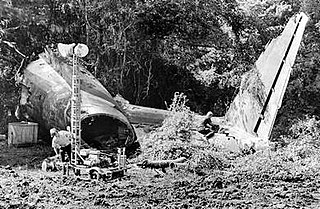
Eastern Air Lines Flight 212 was a controlled flight into terrain accident of a McDonnell Douglas DC-9 during approach to Charlotte Douglas International Airport in North Carolina. The incident occurred on September 11, 1974, killing 72 of the 82 people on board. The scheduled flight was from Charleston Municipal Airport to Chicago O'Hare, with an intermediate stop in Charlotte.
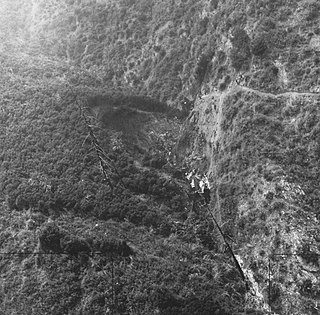
Hughes Airwest Flight 706 was a regularly scheduled flight operated by American domestic airline Hughes Airwest from Los Angeles, California to Seattle, Washington, with several intermediate stops. On Sunday, June 6, 1971, the McDonnell Douglas DC-9 serving as Flight 706 departed Los Angeles just after 6 p.m. en route to Seattle as a McDonnell Douglas F-4 Phantom II of the United States Marine Corps was approaching Marine Corps Air Station El Toro near Irvine, California at the end of a flight from Naval Air Station Fallon in Nevada. The two aircraft collided in midair over the San Gabriel Mountains near Duarte, California, killing all passengers and crew on the DC-9 as well as the F-4's pilot. The F-4's radar intercept officer survived.
Gregory Allen Feith is an American former Senior Air Safety Investigator with the National Transportation Safety Board (NTSB). He currently works as a consultant on aviation safety and security matters in the private sector, and as the aviation expert for NBC and MSNBC. He also serves as the technical advisor in a number of television programs such as Mayday, Seconds From Disaster, and Why Planes Crash while maintaining a busy speaking schedule.

Colgan Air Flight 3407 was a scheduled passenger flight from Newark, New Jersey, to Buffalo, New York, which crashed on February 12, 2009. The aircraft, a Bombardier Q400, entered an aerodynamic stall from which it did not recover, and crashed into a house at 6038 Long Street in Clarence Center, New York, at 10:17 pm EST, killing all 49 passengers and crew on board, as well as one person inside the house.

USAir Flight 427 was a scheduled flight from Chicago's O'Hare International Airport to Palm Beach International Airport, Florida, with a stopover at Pittsburgh International Airport. On Thursday, September 8, 1994, the Boeing 737 flying this route crashed in Hopewell Township, Pennsylvania while approaching Runway 28R at Pittsburgh, which was USAir's largest hub at the time.

John F. Kennedy Jr., the son and namesake of the former U.S. President John F. Kennedy, died when the light aircraft he was flying crashed into the Atlantic Ocean off Martha's Vineyard, Massachusetts, on July 16, 1999. Kennedy's wife Carolyn Bessette and sister-in-law Lauren Bessette were also on board and died. The Piper Saratoga departed from New Jersey's Essex County Airport; its intended route was along the coastline of Connecticut and across Rhode Island Sound to Martha's Vineyard Airport.

UPS Airlines Flight 6 was a cargo flight operated by UPS Airlines. On September 3, 2010, the Boeing 747-400F flying the route between Dubai, United Arab Emirates, and Cologne, Germany, developed an in-flight fire, which caused the aircraft to crash, killing both crew members, the only people on board. It was the first fatal air crash for UPS Airlines. The crash prompted a re-evaluation of safety procedures protecting airliners from cockpit smoke.
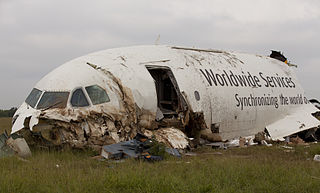
UPS Airlines Flight 1354 (5X1354/UPS1354) was a scheduled cargo flight from Louisville, Kentucky, to Birmingham, Alabama. On August 14, 2013, the Airbus A300 flying the route crashed and burst into flames short of the runway on approach to Birmingham–Shuttlesworth International Airport. Both pilots were pronounced dead at the scene of the crash. They were the only people aboard the aircraft. It was the second fatal air crash for UPS Airlines.

United Airlines Flight 2885 was a scheduled cargo flight from Cleveland to Los Angeles, with stopover in Detroit. On January 11, 1983, a DC-8 operating as Flight 2885 crashed after take-off from Detroit, killing all three crew members. The National Transportation Safety Board (NTSB) investigation determined that the cause for the crash was pilot error. A radioactive package was found on board, but no radioactive material was spilled.

American Airlines Flight 383 was a scheduled passenger flight from O'Hare International Airport in Chicago, Illinois to Miami International Airport. On October 28, 2016, the Boeing 767-300ER operating the flight suffered an engine fire during takeoff. The crew aborted their takeoff, evacuating everyone on board, of whom 21 were injured. The plane was a write-off.


















